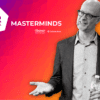
Published on February 21, 2023

Dave Ulrich- Rensis Likert Professor of Business, Ross School of Business, University of Michigan
by Dave Ulrich, Rensis Likert Professor Ross School of Business, University of Michigan, Partner, The RBL Group, dou@umich.edu; Joe Grochowski, Managing Director, RBL Institute, jgrochowski@rbl.net; RBL Team, Norm Smallwood, Joe Hanson, Ernesto Uscher
Attention to people and organization issues has increased with the COVID pandemic, subsequent mental health and well-being concerns, and clear evidence of the impact of people and organization on stakeholder value. In light of this attention, many consulting firms are exploring an HR operating model for how to build an effective HR function to respond to these trends. Many of these models refer to our previous work, so we want to update our work on the HR value logic by reviewing:
- The value of HR for key stakeholders to build the business case.
- Nine recent approaches to characterize today’s HR function.
- Recent research and insights by The RBL Group [RBL] on HR effectiveness leading to an HR value creation logic.
- Action implications for diagnosis and improvements for HR value creation.
1.0 The Value of HR for Key Stakeholders
In our work, HR is not about HR but about the value HR creates for stakeholders. This simple mantra means that we connect the business context and the HR function. We call this the HR value creation logic (see figure 1) because it has an outside-in logic with HR actions designed to create value for stakeholders.
Given this logic, figure 2 summarizes what stakeholders receive from human capability (talent, leadership, organization, and HR department) initiatives, which defines the effectiveness of the HR function.

*The red-outlined yellow box indicates the focus of this article and the associated HR playbook.

2.0 Nine Recent Approaches to Characterize Today’s HR Function
Because of the increased attention to human capability, most leading consulting firms have expanded their HR services to offer clients ideas that will improve the HR function. Each consulting firm suggests a theme for improving HR and focuses on dimensions of the HR function. We have synthesized this work to help discover what thoughtful colleagues recommend for HR functional effectiveness (see figure 3). (More details are available from The RBL Institute by contacting Joe Grochowski at jgrochowski@rbl.net).

3.0 Recent Research and Insights by RBL on HR Effectiveness Leading to an HR Value Creation Logic
We appreciate, learn from, and build on the outstanding work done by our colleagues in these nine (and other) consulting firms, plus exceptional research by so many academic scholars. We believe that HR functional effectiveness requires theory, research, and practice. From theory and research emerge practices and solutions that offer evidence-based insights to make knowledge productive.
We have crafted both long-term and short-term insights through three major research projects that shape HR functional excellence (see figure 4).

3.1 RBL’s View of Characteristics of an Effective HR Function: HR Value
Analyzing the nine models of HR function and our research reported above, we would suggest that any effective HR function has ten dimensions that make up the HR value logic, as highlighted in figure 5. In this figure, we highlight the question for each of the ten dimensions and our contribution on how to answer these questions.

3.2 RBL Comparison to Other HR Functional Models
Given our work on defining HR functional effectiveness into ten dimensions, we highlight how the nine HR operating models compare to RBL and each other in order to help HR leaders know where and how to focus to build functional excellence. Figure 6 shares each of the nine models (columns), the research behind the model (as reported in row 1), and the concepts from these nine models as they relate to the ten HR functional effectiveness work we have done.

We identified a number of observations from this chart. First, the nine operating models use a host of research approaches (some did not report their research) from case studies to targeted interviews to surveys of senior HR leaders to participants in training programs. We are confident that our ideas come from a rigorous research base that guides actions.
Second, while most approaches used the term “customers” of HR, the primary customer is the employee, and HR is designed to increase employee experience (measured by satisfaction, productivity, and retention). Little mention is made of defining HR success through value created for external customers and investors or of including customers and investors in designing and delivering HR practices.
Third, as noted above, almost all discuss a mostly similar design of the HR department (or operating model) using different terms to highlight how HR expertise (specialized knowledge) can be applied to business problems. Roles in an HR department include specialist, generalist, and technology experts. As Marc Effron, a thought leader in the HR space who summarized five of these models, said, “The striking consistency in these approaches to existing HR design suggests that the debate around design is largely settled and HR should now focus on what enables the success of its structure. . . . A new approach to HR design isn’t needed to stay competitive. The model originally championed 20 years ago is still relevant to managing today’s workplace and workforce and can be easily adapted to a variety of situations, as seen in our examination of the identical models used by top consulting firms” (Marc Effron, “It’s the Mortar, not the Bricks: The State of HR Organization Design,” May 14, 2020). We agree.
As we have said previously, HR as a department operates like any professional service firm that turns their knowledge and expertise into their client’s success. The HR department structure or design should match the business structure or design. If a business is centralized (single business), HR is likely to be organized by function (staffing, training, compensation, organization design) for the entire business. If a business is completely decentralized (essentially a holding company), then each business would have its own unique HR functional experts. Since most businesses are some version of both centralization and decentralization (called a multi-divisional firm, allied/related, conglomerate, or diversified), HR’s most common design response is to have specialists (centers of expertise, experts) who have deep expertise and then transfer or adapt their knowledge to HR generalists who work in the business, geography, or functional organization units (see figure 7).

Fourth, the human capability outcomes both within the HR department and what HR offers to a business are focused almost exclusively on employees (at times called workforce, people, or talent) and on the organization capability of agility.
Fifth, analytics plays an increasingly critical role to deliver HR. Most of the analytics is about reporting what HR does more than what it delivers, leading to benchmarks that offer comparisons more than guidance about what actions a specific company might take.
Sixth, we are seeing a dramatic increase in the utilization of digital information through technology to drive efficiency, improve HR practices, and to connect employees who may be working remotely. The digital and technology agenda affects both how HR can help a business integrate technology into its strategic agenda and how HR can use digital information in doing human capability work.
Seventh, we see many lists of competencies that HR professionals should demonstrate, often defined by HR people as knowledge, skills, and abilities they should possess. Few link these competencies to personal, stakeholder, or business outcomes, but we have a call to upgrade HR.
Finally, most models recognize that HR professionals need to work together (with agility, fluidity, collaboration) to bring the elements of HR into an integrated solution.
In brief, the literature of outstanding thinking is growing, and ongoing work continues to deliver HR functional excellence. Like a piano keyboard with 88 keys and some played more than others, many of these HR models are touching on a subset of the ten characteristics of an effective HR function. Our G3HC work on 5,760 companies shows that when human capability work is integrated and complete, better outcomes occur.
4.0 Action Implications for Diagnosis and Improvements for HR Value Creation
Our value logic and research for HR functional excellence builds on previous work, relies on rigorous research, and leads to relevant actions. We propose a six-step logic for improving HR value creation for any organization (see figure 8).

Measuring the ten dimensions is helpful in getting started. Begin with the survey in figure 9 to diagnose and help prioritize where to focus. This is a perceptual survey that can be filled out over and over by both HR professionals and other stakeholders to track current state and progress.

Conclusion
Making the HR function more effective becomes ever more critical in today’s changing business context. Many thoughtful colleagues are engaged in upgrading HR work. As we review these nine models and our research, we propose an HR value logic with ten dimensions of an effective HR function. By improving on these ten dimensions, HR leaders will help create human capability (talent, leadership, organization, and HR department) that will then be used to deliver stakeholder value.
The best is always yet ahead. We hope we can help you create your value added HR function.
..………
Dave Ulrich is the Rensis Likert Professor at the Ross School of Business, University of Michigan, and a partner at The RBL Group, a consulting firm focused on helping organizations and leaders deliver value.
………
Dave Ulrich is the Rensis Likert Professor at the Ross School of Business, University of Michigan, and a partner at The RBL Group, a consulting firm focused on helping organizations and leaders deliver value.
Meet Dave Ulrich in person:

Written by: Katalin Toth
Culture Dave Ulrich Future of Work HR Strategy Leadership
Previous post

- 1048
labelArticles today2023.02.23.
Employee Experience: 10 future trends in the workplace
By Heleen Mes, Founder of HXWork & Author of Employee Experience; happy people, better business Employee experience is an employee’s experience and emotions when interacting with the organization, and the [...]
Similar posts

labelArticles today2024.10.21.
The success-recipe to build agile and future-ready organizations in 2025 and beyond








Post comments (0)